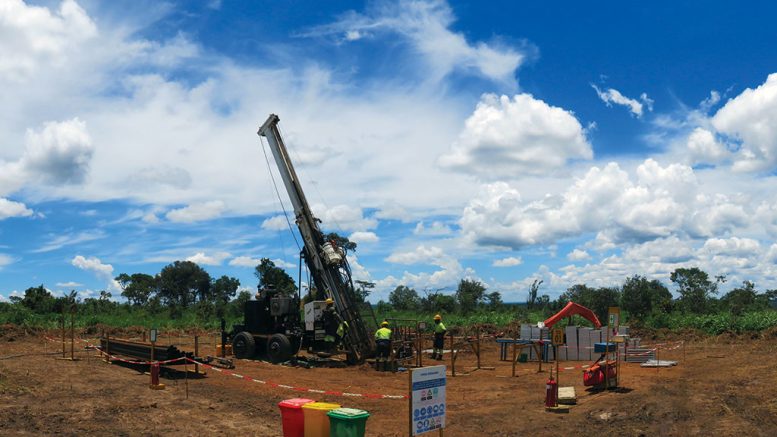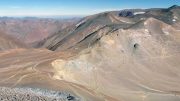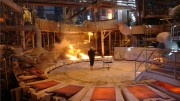In January, Ivanhoe Mines (TSX: IVN; US-OTC: IVPAF) reported a 22-metre intercept of 13.05% copper at a 2% cut-off in a shallow, flat-lying discovery sitting within 190 metres of surface at Kamoa North, an exploration area on the company’s Kamoa-Kakula mining licence in the Democratic Republic of the Congo (DRC).
The drill hole — 1450 — is 18 km north of the Kamoa-Kakula project’s planned initial mine at the Kakula deposit, and 8 km north of Kamoa’s Kansoko mine development.
Ivanhoe founder and executive co-chairman Robert Friedland said at the time that 1450 “exceeds anything encountered in all of our years of delineating resources on the project,” and noted that the flat-lying, 10% copper intersection is “almost 30 metres, or 100 feet thick — essentially equivalent to a 10-storey building — and the high-grade copper is less than 200 metres below surface.”
If a 5% copper cut-off were applied to the intercept, he continued, the grade would increase to 16% copper, and it would be 17 metres thick.
“Hole 1450 is three times richer on a copper-grade-times-thickness measurement than any previous hole drilled at Kamoa-Kakula,” the mining executive said. “Now, our immediate exploration focus is to find more of this near-surface, bonanza-grade ore.”
The company has drilled nine holes in the discovery area, and assays are pending for eight of them. In a March 28 press release, the company reports that “based on visual interpretation of massive bornite and chalcopyrite in the recent drill intersections, the new, high-grade zone of shallow, thick, flat-lying, copper mineralization has been extended over a strike length of at least 200 metres, a width of up to 80 metres, and a drilled thickness of between 13 and 30 metres.”

An access and ventilation tunnel under construction on the south side of Ivanhoe Mines’ Kakula copper deposit in the Democratic Republic of the Congo. Credit: Ivanhoe Mines.
The company says that more drilling is testing the strike and width of the east- to west-trending fault structure that hosts the copper.
The discovery hole is associated with an east- to west-trending fault structure, where copper-rich fluids flowed into the stratigraphy above the conventional Kamoa-Kakula mineralization, and into a zone called the Kamoa pyritic siltstone (KPS), the company says.
Ivanhoe says that the controlling east- to west-striking fault responsible for the copper sulphide mineralization in KPS appears on airborne magnetic images, and can be traced over 10 to 20 kilometres. In addition, it trends west of Kamoa-Kakula onto the company’s wholly owned Western Foreland exploration licences.
The company is also exploring another zone of shallow, high-grade copper mineralization in the far northern region of the Kamoa-Kakula mining licence, where a north- to south-mineralized corridor trends “for more than 9 km before swinging to the northwest, and is projected to continue onto the adjacent Western Foreland exploration licences.”
Ivanhoe recently discovered Makoko on its Western Foreland concessions. It is the company’s third major copper discovery in the DRC, and has similar geology to the Kamoa-Kakula discoveries.
The discovery hole 4 at Makoko — drilled in September, and announced in October 2017 — intersected 4 metres of 5.46% copper at a 2% copper cut-off from a downhole depth of 306 metres.
Highlights from other holes include 3 metres of 6.78% copper at a 2% copper cut-off from 441 metres downhole in hole 10, and 3 metres of 6.49% copper at the same cut-off grade, 472 metres downhole in hole 17. Hole 25 cut 3 metres of 7.61% copper from 406 metres downhole, and hole 46 assayed 7.81% copper over 7 metres from 524 metres’ depth.
Drilling at Makoko has defined a flat-lying, near-surface stratiform copper deposit similar to the Kamoa and Kakula deposits, the company says. Based on the structure contour map, it says the mineralized formation in the Makoko area occurs within 1,000 metres of surface, and most of the drilling has intersected the copper-rich zone between 400 metres and 800 metres below surface. The mineralized zone strikes south to southeast, and has been tested over a 4.5 km strike length and a dip extent of between 1 and 2 kilometres. The copper mineralization remains open along strike and down dip.
Ivanhoe started exploring the West Foreland licences in the third quarter of 2017, and has earmarked US$16 million for regional exploration there this year.
“While some investors are focused on short-term issues, such as the DRC Mining Code revisions and the upcoming presidential election,” Friedland said in January, “Ivanhoe’s philosophy is to think big and think long-term. Our geological team has done an outstanding job of executing our strategy to continue to add shareholder and stakeholder value by keeping the drill bits turning, and delivering spectacular exploration results.”






Be the first to comment on "Ivanhoe tests area near Kamoa North discovery hole"